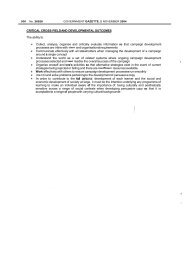Macroeconomic strategies, agriculture and rural poverty in post ...
Macroeconomic strategies, agriculture and rural poverty in post ...
Macroeconomic strategies, agriculture and rural poverty in post ...
Create successful ePaper yourself
Turn your PDF publications into a flip-book with our unique Google optimized e-Paper software.
Dur<strong>in</strong>g the drought of the 1990s, economists calculated that low agricultural yields negatively<br />
affected GDP growth by between 0.5 <strong>and</strong> 2%, a stagger<strong>in</strong>g figure for a sector which is<br />
apparently play<strong>in</strong>g a relatively small role <strong>in</strong> the economy. In higher ra<strong>in</strong>fall years the impact<br />
of <strong>agriculture</strong> on the economy is equally significant, but <strong>in</strong> the opposite direction: <strong>in</strong> 1994, a<br />
year of above average ra<strong>in</strong>fall, a 16.3% rise <strong>in</strong> gross farm <strong>in</strong>come caused the economy to grow<br />
for the first time s<strong>in</strong>ce 1989 (F<strong>in</strong>ancial Mail 27 May 1994). The <strong>in</strong>direct role of agricultural<br />
production on growth is a function of the strong forward <strong>and</strong> backward l<strong>in</strong>kages <strong>agriculture</strong><br />
has with the rest of the economy. Fertiliser, chemical <strong>and</strong> implement manufacturers are<br />
dependent on a grow<strong>in</strong>g agricultural economy. In the 1993/4 season, for <strong>in</strong>stance, farmers<br />
spent over R500 million on pack<strong>in</strong>g material, R1.6 billion on fuel, R1.18 billion on fertilizers<br />
<strong>and</strong> R1 billion on dips <strong>and</strong> sprays (Abstract of Agricultural Statistics 1995). Many of these<br />
companies are dependent on the sale of chemicals <strong>and</strong> mach<strong>in</strong>ery to farmers. There are also<br />
important forward l<strong>in</strong>kages between <strong>agriculture</strong> <strong>and</strong> <strong>in</strong>dustry. In the early 1990s, only 34% of<br />
what farmers produced was consumed directly; the rema<strong>in</strong><strong>in</strong>g 66% was processed <strong>in</strong> some<br />
form by the manufactur<strong>in</strong>g sector.<br />
Economists have spent considerable effort specify<strong>in</strong>g the larger <strong>in</strong>direct role of<br />
<strong>agriculture</strong> <strong>in</strong> the economy by exam<strong>in</strong><strong>in</strong>g the forward <strong>and</strong> backward l<strong>in</strong>kages between<br />
<strong>agriculture</strong> <strong>and</strong> other sectors through <strong>in</strong>put-output analysis (van Zyl <strong>and</strong> V<strong>in</strong>k 1988; van<br />
Seventer, Faux, van Zyl 1992) <strong>and</strong> by simulat<strong>in</strong>g the impact of periodic droughts on growth<br />
<strong>and</strong> employment (Pretorius <strong>and</strong> Smal 1992; van Zyl et al, 1988). In 1995 the total agricultural<br />
output was almost R39 billion. To produce this amount of output, the sector’s dependent on<br />
<strong>in</strong>puts from non-agricultural sectors of the economy was equivalent to 43.4% of its total<br />
value of output, especially from the food sector, <strong>in</strong>dustrial chemicals <strong>and</strong> other chemical<br />
sectors, <strong>and</strong> the trade, cater<strong>in</strong>g <strong>and</strong> accommodation sector. Remuneration of employees <strong>and</strong><br />
gross operat<strong>in</strong>g surplus constituted 11.7% <strong>and</strong> 36.7% of the value of total output,<br />
respectively. On the expenditure side, domestic agricultural outputs provided for 93.3% of<br />
total expenditure on this sector’s products <strong>in</strong> 1995. The largest dem<strong>and</strong> for agricultural<br />
sector’s outputs comes from the <strong>in</strong>termediate <strong>in</strong>put needs of the non-agricultural sectors of<br />
the economy amount<strong>in</strong>g to 56.5% of total expenditure on agricultural products <strong>in</strong> 1995.<br />
Other major consumers of agricultural products were the domestic private consumption<br />
(28.7%) <strong>and</strong> exports (13%).<br />
This <strong>in</strong>terdependency between <strong>agriculture</strong> sector <strong>and</strong> the rest of the economy has been<br />
the basis of the empirical evidence that <strong>in</strong>creases <strong>in</strong> agricultural production have large positive<br />
impacts on growth, employment <strong>and</strong> the balance of payments. Us<strong>in</strong>g the 1995 <strong>in</strong>put output<br />
table of South Africa, our calculation shows that for every R1 million of autonomous<br />
expenditure on agricultural production, the agricultural output <strong>in</strong>creases by R1.38 million<br />
while the overall economic output <strong>in</strong>creases by R6.51 million. This means that for every R1<br />
million of expenditure on agricultural production, an equivalent of extra R4.13 million is<br />
generated <strong>in</strong> other sectors of the economy. Agriculture also has a strong multiplier effect on<br />
employment. Our evaluation of the sectoral employment multipliers for the year 1995<br />
confirms the recent study by the Department of Agriculture (1996) <strong>and</strong> the earlier study by<br />
van Zyl <strong>and</strong> V<strong>in</strong>k (1988) that more jobs are created <strong>in</strong> <strong>agriculture</strong> with <strong>in</strong>creased production<br />
than for any other sector of the economy. Specifically, the effect of a R1 million <strong>in</strong>crease <strong>in</strong><br />
expenditure on agricultural production is an overall economy-wide employment <strong>in</strong>crease of<br />
75 persons which is divided between direct employment <strong>in</strong>crease <strong>in</strong> the <strong>agriculture</strong> sector of<br />
30 persons <strong>and</strong> an extra 45 employees <strong>in</strong> the rest of the economy. Simulations of drought on<br />
employment reveals how vulnerable farm workers are to low ra<strong>in</strong>fall <strong>and</strong> crop failure.<br />
Pretorius <strong>and</strong> Smal (1992) estimated that the direct impact of the 1992 drought on<br />
agricultural employment was a loss of 49,000 jobs. They also predicted that an additional<br />
3

















